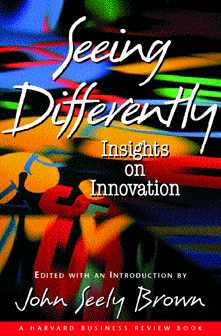|
| ||
 |
A Business Forum Book Review:
Insights on Innovation |
Competitive advantage is gained only by seeing product/service/market opportunities differently than others. The key to effective innovation is seeing opportunities that are unseen by others. Of course, this may be dismissed simply as a truism. In a world populated with bright and restless competitors, how can one see opportunities that are invisible to othSeeing Differently: Insights on Innovation, edited with an introduction by John Seely Brown (Harvard Business School Press, 288 pages, $29.95) is a focused selection of twelve recent articles from the Harvard Business Review. Each of these articles presents case studies of successful product/service/market opportunities that were unseen or ignored by others. Innovation is the progeny of a nurturing entrepreneurial culture, not the product of a superior methods and procedures manual.
Quite simply, all history is the chronicle of the continual emergence of new tools and new rules. The leaders in every era are those persons and their institutions that grasp the significance of these new tools and new rules. Today, our global economy is bursting with revolutionary changes in information and communications technology. In his perceptive and comprehensive Introduction, Dr. Brown emphasizes, "The challenge lies in our ability to make sense of the rapidly changing context in which we are doing business. We need to find new ways of doing things, whether we are working on new solutions to old problems or creating new ways of doing things that have never been done -- or even thought of -- before."
Understandably, it is impossible to encapsulate in one snappy synopsis the span of the messages offered in these twelve articles written by 20 authors. Just one excellent insight is found in "Disruptive Technologies: Catching the Wave," by Joseph L. Bower and Clayton M. Christensen. "... leading companies succumb to one of the most popular, and valuable, management dogmas. They stay close to their customers. ... But what happens when customers reject a new technology, product concept, or way of doing business because it does not address their needs as effectively as a company’s current approach? ... In each instance, companies listened to their customers, gave them the product performance they were looking for, and, in the end, were hurt by the very technologies their customers led them to ignore. ... In fact, the processes and incentives that companies use to keep focused on their main customers work so well that they blind those companies to important new technologies in emerging markets." Dr. Brown observes, "Particularly when dealing with emerging technologies and emerging markets, the voice of the customer should not be heard as definitive."
Similarly, an excellent insight is offered in "Managing Innovation in the Information Age" by Rebecca Henderson. Based upon research undertaken with Professor Iain Cockburn, Henderson discloses the "... characteristics shared by the most successful pharmaceutical companies: first, they kept abreast of the changes in their field by making and maintaining close connections with the scientific community at large; second, they allocated resources across a wide range of therapeutic areas, ending up with the most advantageous mix of projects; and, finally, they actively confronted the tension between organizing by function and organizing by product group." She warns that many companies stumble because "... [t]hey have become prisoners of the deeply ingrained assumptions, information filters, and problem-solving strategies that make up their world views, turning the solutions that once made them great into new problems to be resolved."
And Andrall E. Pearson in "Tough-Minded Ways to Get Innovative" observes, "Even the best concepts or strategies tend to develop incrementally. They rarely ever work the first time out or unfold just as they were planned. In fact, the original concept or its execution usually gets changed considerably before it’s ready to be implemented broadly. ... So even after you spot a promising segment and develop a product to serve it, you’ve usually still got at least one major hurdle to jump before you can capitalize on your new idea."
Seeing Differently offers informed insights on innovation to help the entrepreneurial leader understand the new tools and the new rules emerging in today’s global economy. The immediacy of the well-known case studies provide noteworthy models and inspiration for one’s own venture. Dr. Brown concludes, "When people from different worlds are able to come together and engage in a productive way, innovation is more likely to happen. Much of what we think of as innovation is the product of the creative tension between varied perspectives. ... The opportunities are boundless for those who are able to step back, adjust their vision, and begin to make sense."
Your comments and suggestions for these pages are most welcome!
|
Email: editor@businessforum.com
|
URL: http://www.businessforum.com/sbrown.html
Revised: August 5, 1999 TAF
© Copyright 1997, 1999 Thomas A. Faulhaber / The Business Forum Online®, All Rights Reserved.